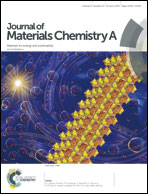Boosting the oxygen evolution reaction in non-precious catalysts by structural and electronic engineering†
Abstract
The oxygen evolution reaction (OER) plays a key role in many energy storage applications. It remains a big challenge to fabricate non-precious OER electrocatalysts with both excellent activity and high stability. Herein, we demonstrate that excellent OER performance can be achieved by applying structural and electronic engineering simultaneously. As a proof of concept, 1D vertically aligned Ni3S2 nanorods (without any entangled or inter-crossed nanostructure on the top) are firstly synthesized to provide both conducting highways and rich active sites with significantly facilitated gas release during the OER. A highly active Ni–Fe layered double hydroxide (LDH) nanofilm is then prepared on the Ni3S2 nanorod to form a core@shell structure. The strong interfacial coupling between the in situ grown Ni–Fe LDH and Ni3S2 creates abundant oxygen vacancies to effectively lower the adsorption energy of OH−. Consequently, Ni3S2@Ni–Fe LDH exhibits superior OER activity and outstanding stability. The overpotential of Ni3S2@Ni–Fe LDH prepared on nickel foam is only 190 mV at 10 mA cm−2 and the Tafel slope is as low as 38 mV dec−1. The OER performance remains constant after 40 hours of water electrolysis. Our material is among the best non-precious OER catalysts reported so far. The methodology of enhancing the catalytic performance reported here can be extended to other materials for the design and fabrication of low cost OER catalysts with excellent activity.



 Please wait while we load your content...
Please wait while we load your content...